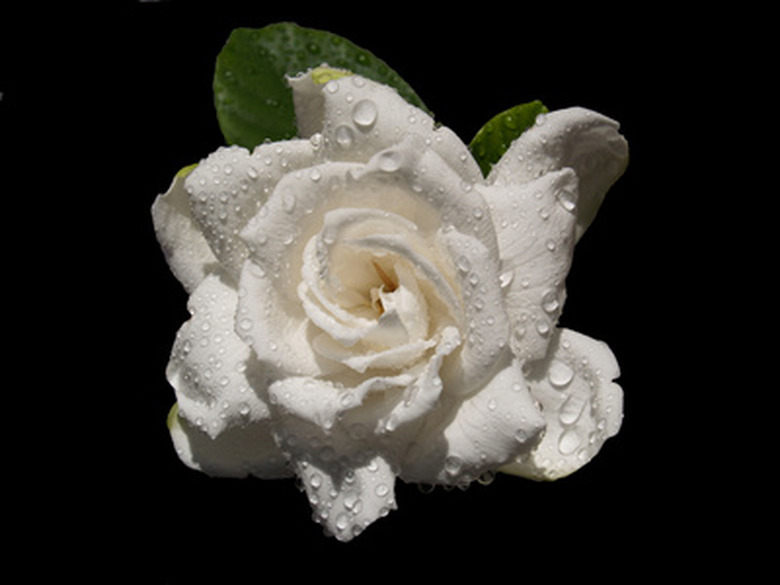How To Grow Gardenias In Virginia
Things Needed
- pH testing kit
- Soil amendments
- Compost
- Shovel
- Gardening fork
- Fertilizer
- Mulch
- Large plastic bag or tarp
- Heat source
The gardenia is a challenge to grow in all but tropical climates. Many a gardener has found themselves staring wistfully at the gardenia display at the local nursery wondering if they should give the plant one last try. Gardenias are finicky plants, but if you pay close attention to their needsm you will be successful at growing them. Most of Virginia lies in USDA hardiness zones 6b in the west, to 7a in Richmond and mid-state and 7b in the east. Virginia Beach and the Norfolk area are in zone 8. While gardenia is hardy to USDA zones 8b to 11, the Kleim's Hardy or Daisy varieties are better able to tolerate the cooler temperatures in western Virginia. Plant the gardenia in the fall or spring.
- The gardenia is a challenge to grow in all but tropical climates.
- While gardenia is hardy to USDA zones 8b to 11, the Kleim's Hardy or Daisy varieties are better able to tolerate the cooler temperatures in western Virginia.
Step 1
Find the warmest spot in your garden in which to grow the gardenia. It should be in full sun to dappled shade and sheltered from the wind.
Step 2
Perform a soil pH test. The gardenia plant requires acidic soil, from 5.0 to 6.5. You can purchase an inexpensive soil testing kit or take a soil sample to the county cooperative extension office for analysis. Be sure to let the agent know that you are going to be growing gardenia so she can give you suggestions on soil amendments for your particular soil.
Step 3
Dig into the soil in the planting area to a depth of 12 inches. You will need to aerate the soil and remove any large clods of dirt, rocks and other debris. Use the gardening fork to toss the soil and crush it.
- Find the warmest spot in your garden in which to grow the gardenia.
- Be sure to let the agent know that you are going to be growing gardenia so she can give you suggestions on soil amendments for your particular soil.
Step 4
Lay down a 3-inch layer of compost or well-rotted manure and any soil amendments suggested by the pH analysis and mix those in to the top 8 inches of soil. Level the area with a rake.
Step 5
Dig a hole the same depth but three times the width of the pot in which the gardenia is being grown. Gently remove the gardenia from the pot, being very careful not to disturb the root ball, and place the roots in the hole. Backfill the hole with the amended soil and tamp lightly around the base of the plant.
Step 6
Water the gardenia until the water puddles and then give it 1 inch of water a week.
Step 7
Place a 3-inch layer of mulch around the gardenia and spread it out the same width as the top of the plant. Do not allow the mulch to touch the trunk of the bush. Prior to the first frost in your part of Virginia, add another 2 inches of mulch around the plant.
- Lay down a 3-inch layer of compost or well-rotted manure and any soil amendments suggested by the pH analysis and mix those in to the top 8 inches of soil.
- Water the gardenia until the water puddles and then give it 1 inch of water a week.
Step 8
Fertilize the gardenia in mid-March and again in late June. Use a fertilizer for acid-loving plants, such azalea food. Gardenias grown in Virginia should not be fertilized in the fall as that will encourage new growth that will be killed with the arrival of frost.
Step 9
Inspect the gardenia for signs of white flies. Virginia-grown gardenias are especially attractive to this pest. White flies look like tiny, white moths and leave a secretion that will mold and turn black. A pesticide that contains imidacloprid works well on this pest.
- Fertilize the gardenia in mid-March and again in late June.
- Gardenias grown in Virginia should not be fertilized in the fall as that will encourage new growth that will be killed with the arrival of frost.
Step 10
Protect the gardenia from the frost in Virginia by covering it. If the plant is small enough, a large garbage bag will provide protection. Otherwise, use a tarp. Heat, such as from Christmas tree lights, under the tarp may help as well.
Warning
Fertilizer and pesticides can contain harmful chemicals. Read and follow all label directions.
